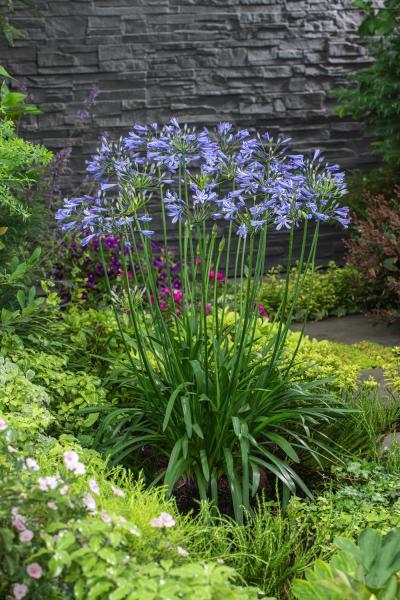Understanding the Art of Agapanthus Treatment: Important Actions for Healthy Development and Vivid Flowers
In the world of horticulture, the cultivation of agapanthus stands as a fulfilling undertaking for those that seek to nurture these elegant blooming plants. From choosing the appropriate selection to understanding trimming methods, the journey in the direction of cultivating thriving agapanthus plants is complex and holds the crucial to unlocking the complete capacity of these agricultural treasures.

Picking the Right Agapanthus Variety

When selecting the appropriate Agapanthus range for your garden, take into consideration variables such as environment suitability, bloom color, and development behavior. Furthermore, consider the climate in your area to guarantee the Agapanthus selection you select can flourish in your details conditions. Recognizing the development behavior of different Agapanthus selections is important for proper placement within your yard.
Perfect Planting Conditions
Thinking about the optimum ecological requirements is necessary for effective Agapanthus cultivation. Agapanthus plants are sensitive to cool temperatures and ought to be secured from frost throughout wintertime months.
To make sure healthy development and vivid blossoms, plant Agapanthus light bulbs at a deepness of regarding 2-4 inches and area them 8-12 inches apart. Including organic issue, such as garden compost, to the dirt can improve drainage and fertility, promoting robust root advancement. Mulching around the base of the plants helps keep dampness and suppresses weed growth. Regular watering is critical, especially during the growing season, to maintain the dirt continually wet however not soaked.
Watering and Fertilizing Tips
Maintaining correct wetness degrees and offering necessary nutrients are crucial elements in the treatment regimen for Agapanthus plants. It is vital to strike a balance when it comes to sprinkling Agapanthus. If overwatered, these plants choose continually damp soil however are susceptible to root rot. Throughout the expanding period, water deeply once a week, ensuring the dirt is well-draining to stop waterlogging. In hotter climates or during periods of dry spell, more constant watering may be needed to keep the dirt evenly moist. However, lower watering in the wintertime to stop water logged problems.
Fertilizing Agapanthus is necessary for promoting healthy development and respected blossoms. Use a balanced plant food, such as a 10-10-10 formula, in the very early springtime as brand-new growth arises. Repeat this application every 6-8 weeks throughout the expanding season. Avoid excessive fertilizing, as it can lead to lush foliage at the expenditure of blooms. Constantly adhere to the producer's instructions for appropriate dilution and website link application techniques. By following these watering and feeding tips, you can ensure your Agapanthus plants thrive and create lively, long-lasting blooms.
Pruning Strategies for Agapanthus
Pruning Agapanthus plants at the proper times and with appropriate techniques is crucial for keeping their wellness and promoting ideal development and blooming. The suitable time to prune Agapanthus is in late winter months or very early springtime before new development emerges.
For flowered stems, wait till the blossoms have withered and afterwards cut them back to the base. This not just cleans up the plant's look but also encourages the growth of brand-new flower buds. Deadheading spent blossoms can also reroute the plant's power into generating even more blooms rather than establishing seeds. Nevertheless, if you want to collect seeds for breeding, leave some blossoms to mature and completely dry on the plant.
Remember to utilize clean, sharp devices to make additional resources precise cuts and lower the risk of introducing diseases. Agapanthus. Routine trimming will aid maintain your Agapanthus looking healthy and balanced and cool while making certain a plentiful display screen of lovely blooms
Taking Care Of Common Insects and Diseases
After guaranteeing correct pruning techniques for Agapanthus, it is necessary to deal with common bugs and conditions that can influence the wellness and vitality of these plants. One typical parasite that affects Agapanthus is the Agapanthus gall midge.
One more usual problem is fungal fallen leave spot, which provides as dark sores on the leaves. To avoid fungal illness, make certain excellent air circulation around the plants, avoid overhanging watering, and remove any type of contaminated fallen leaves without delay. In addition, Agapanthus plants can experience origin rot if they are grown in try this poorly draining dirt. To avoid this, plant Agapanthus in well-draining soil and avoid overwatering. By being attentive and taking timely activity versus illness and insects, you can assist your Agapanthus plants grow and create dynamic blooms.

Conclusion
Finally, mastering the art of agapanthus treatment involves selecting the best range, offering excellent planting problems, appropriate watering and fertilizing, proper pruning methods, and resolving common insects and conditions. By adhering to these vital actions, you can make sure healthy development and vibrant blossoms for your agapanthus plants. Remember to regularly keep track of and maintain your plants to advertise their general wellness and long life.
To make certain healthy and balanced development and vivid blooms, plant Agapanthus light bulbs at a deepness of regarding 2-4 inches and space them 8-12 inches apart. By following these watering and feeding suggestions, you can guarantee your Agapanthus plants prosper and generate vivid, resilient blooms.
One usual insect that influences Agapanthus is the Agapanthus gall midget. In addition, Agapanthus plants can endure from root rot if they are grown in poorly draining pipes dirt. By following these essential actions, you can ensure healthy growth and vibrant blooms for your agapanthus plants.